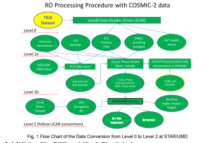Error Propagation from the Precise Orbit Determination and Clock Uncertainty Estimates to Bending Angle in the STAR’s COSMIC-2 Processing System
Bin
Zhang
CISESS/ESSIC, University of Maryland, College Park
Poster
Launched on June 25, 2019, COSMIC-2/FORMOSAT-7 is a-six satellite constellation mission with a 24-degree inclination orbit at 720 km altitude. COSMIC-2 mission is a partnering satellite program among US National Oceanic and Atmospheric Administration (NOAA), US Air Force (USAF), Taiwan's National Space Organization (NSPO), and the University Corporation for Atmospheric Research (UCAR). The UCAR COSMIC Data Analysis and Archive Center (CDAAC) is the COSMIC-2 operational data processing center, the National Environmental Satellite, Data, and Information Service (NESDIS) Center for Satellite Applications and Research (STAR) is the COSMIC-2 re-processing and quality monitoring center in NOAA.
To understand the COSMIC-2 data uncertainty induced in each step of the RO processing, the University of Maryland (UMD) and NESDIS/STAR developed an independent processing package to convert the COSMIC-2 pseudo-range and carrier phase observations to excess phases. We use the Bernese software to solve the LEO satellite clock bias and test the precise orbit determination (POD). The Radio Occultation Processing Package (ROPP) was used to convert the newly derived excess phase to bending angles.
This study examines the STAR COSMIC-2 POD results and explores the impact of different POD solutions on the bending angle retrievals. Multiple POD results of the same LEO satellite are available in the UCAR level1b dataset. However, only one is used for excess and bending angle calculation in operations. The POD from multiple solutions have uncertainty/difference ranges from centimeter levels to meter level. The POD solution change in time can impact the bending angle through derived additional Doppler in excess frequency. On the other hand, the COSMIC-2 single differencing clock bias correction is between observations from two antennas. The POD solution uncertainty can impact the clock bias removal in excess phase due to the POD uncertainty impact on the direct link removal in single differencing.
Unlike COSMIC-1, COSMIC-2 does not have a high-rate POD observation of reference GNSS satellite for single differencing. We will also evaluate the uncertainties in Clock bias (determined from using the single difference and zero difference) in the excess phase. We then use our excess phase package to quantify how the excess phase retrievals vary from different POD and clock bias estimates. Furthermore, the COSMIC-2 raw carrier phase displays a significant amount of cycle slips. Using of accurate excess phase model simulated from climatology is critical in cycle slip corrections. However, different excess phase simulated using a different model and forward operators can generate different excess phase profiles. How this model difference affects the excess phase and bending angle, refractivity, and dry temperature profiles, especially at the open-loop stage near lower 10 km near the surface, is also discussed.
To understand the COSMIC-2 data uncertainty induced in each step of the RO processing, the University of Maryland (UMD) and NESDIS/STAR developed an independent processing package to convert the COSMIC-2 pseudo-range and carrier phase observations to excess phases. We use the Bernese software to solve the LEO satellite clock bias and test the precise orbit determination (POD). The Radio Occultation Processing Package (ROPP) was used to convert the newly derived excess phase to bending angles.
This study examines the STAR COSMIC-2 POD results and explores the impact of different POD solutions on the bending angle retrievals. Multiple POD results of the same LEO satellite are available in the UCAR level1b dataset. However, only one is used for excess and bending angle calculation in operations. The POD from multiple solutions have uncertainty/difference ranges from centimeter levels to meter level. The POD solution change in time can impact the bending angle through derived additional Doppler in excess frequency. On the other hand, the COSMIC-2 single differencing clock bias correction is between observations from two antennas. The POD solution uncertainty can impact the clock bias removal in excess phase due to the POD uncertainty impact on the direct link removal in single differencing.
Unlike COSMIC-1, COSMIC-2 does not have a high-rate POD observation of reference GNSS satellite for single differencing. We will also evaluate the uncertainties in Clock bias (determined from using the single difference and zero difference) in the excess phase. We then use our excess phase package to quantify how the excess phase retrievals vary from different POD and clock bias estimates. Furthermore, the COSMIC-2 raw carrier phase displays a significant amount of cycle slips. Using of accurate excess phase model simulated from climatology is critical in cycle slip corrections. However, different excess phase simulated using a different model and forward operators can generate different excess phase profiles. How this model difference affects the excess phase and bending angle, refractivity, and dry temperature profiles, especially at the open-loop stage near lower 10 km near the surface, is also discussed.

Poster PDF